Once upon a time, Starbucks iced soy chais were a big part of my life. The funny part is I do not actually remember why I started drinking them – I suspect it had to do with the fact I did not love Starbucks coffee and perceived chai as a healthier alternative – ironic, as Starbucks chai packs plenty of sugar and caffeine. At some point in late 2008 (interestingly, prior to changing my diet far more significantly the following year) I decided it was time to break up with the constant chai habit, particularly when I realized how much sugar and caffeine Starbucks chai contained . Eventually, though, I stopped missing my chai runs, but I continued to miss Starbucks, which had sort of been my happy place for a long time (i.e. no matter where I was, I loved how Starbucks was a setting I associated with relaxation), far longer than I missed the chai itself.
Over the years, I went from a Starbucks chai afficionado to a green juice drinker. As someone who is prone to dehydration and digestive distress, green juice has been very helpful – it is a nice way to get a concentrated source of vitamins and other minerals, and a good complement to the whole-foods based, gluten-free, vegan diet I eat. Even though it’s been several years since I switched to a gluten-free diet, 30 years of gluten-eating when it causes me an autoimmune reaction did me no favors digestion-wise. Green juice is more of a snack for me, or a supplement to a meal, while a nutrient-dense green smoothie (with at least a couple of protein and fat sources, such as hemp seeds, tahini, protein power, or pumpkin seeds) is a great breakfast. I like having both in my diet, but I do not consider green juice to be a meal replacement in any way.
I am particularly in love with sweetpress, a Washington-DC based local pressed juice brand, part of sweetgreen (also known as my favorite salad place, ever). I love sweetpress because it combines convenience with high-quality organic produce, all pressed into lovely little bottles. I make green juice at home (using a masticating juicer, which allows me to store the juice for a couple of days), but I rely on sweetpress when I need to save time or simply crave the convenience. I eat a lot of raw and love my green juice, the fresher the better. While I am not a believer in the enzyme theory often associated with raw foods, I am a big believer in freshness, so to me the benefit of green juice is its freshness and lack of oxidization – much the same way I like my apples freshly sliced and not turning brown. I do not bother with heat-pasteurized juices and was glad to see sweetpress open. Sweetpress is about as close what I can make at home – the juice is organic and it expires in a couple of days – and has been such a nice addition to my life. I no longer have to rely on just myself for juice.
That said, when I travel (which I do more of at my job than I did previously), there is no sweetpress, nor do I have the bandwith or interest to travel with a juicer (or frankly, the time to use it at destination). I really would love if green juice was available in airports (see, above, dehydration tendencies, even worse when I fly). In the meantime, I rely on local juice bars, if available, or pick up Blueprint green juice at Whole Foods, if available. If there are zero juice options, then I just focus on trying to get in more salads than I already do, but I also don’t worry about the lack of green juices or smoothies for a few days. I like Blueprint fine, especially as now Blueprint is 100% USDA certified organic though I do like how sweetpress is a more local option, in addition to being organic.
Also, in contrast to sweetpress or other local juiceries in other cities, Blueprint juice takes about 10 days to expire from what I can tell from the expiration dates. Blueprint uses high pressure processing (HPP) to pasteurize, instead of heat. Even prior to sweetpress opening, I was curious about buying pressed juice, especially when I read an article last year in the Wall Street Journal about Starbucks’ acquisition of Evolution Fresh, a West Coast based juice bar / company which was the first U.S. juicery to use HPP. I wondered what the end product sold at Starbucks would be like, both in terms of quality of ingredients and actual flavor. Evolution Fresh is sold in other locations, but when I read that Starbucks had purchased the company, I immediately thought “green juice at Starbucks?”
Why, yes, indeed:
The thing with vegetable juice is, it is not a new concept. My parents had a juicer when I was a little kid, making carrot ginger juice frequently (to my child’s palate, I thought that concoction was spicy and well, not kid friendly). Jack Lalanne sold his first juicer back in the 1980s. And there are reports of Dr. BIrcher-Benner, a Swiss doctor, espousing the virtues of raw foods and juice back in the early part of last century. The big difference now is technology like HPP. And since, clearly, I have a bit of a soft spot for Starbucks (10+ years of chai will do that), I was that much more curious how technology like HPP and Starbucks’ market share.
I was reminded of last year’s WSJ article this when I read an article in United’s in-flight magazine about Evolution Fresh, Starbucks acquiring it and slightly rebranding it, and HPP. Then, when I was in San Francisco walking back to the hotel with my husband from an dinner meal at Millenium (epic recap coming soon) I spied an Evolution Fresh poster walking by a Starbucks. Next thing my husband knew, I was in the Starbucks, looking around the case for the pressed juice.
There were several fruit-based types, but I was curious about the green juice and the carrot-based juice. According to the cashier, the Evolution Fresh juices were very new – they had only hit that one store in the previous week. In fact, I kept an eye out for more Evolution Fresh posters when passing other Starbucks stores while in San Francisco, and did not see any.
I know HPP can make fresh pressed juice keep for for extra weeks, but an October expiration date when it is barely the end of August seems crazy. Blueprint usually has about 10 days of shelf life, and they also use HPP. I took both bottles of Evolution Fresh juice back to the hotel and stowed them in the fridge (I always ask for a fridge in a hotel room, to store probiotics, but also because it gives me more flexibility for food, key when eating gluten-free is a necessity). These bottles are oddly slippery – they have a tendency to fly from the hand, as both my husband and I noticed.
The next morning I dug into my juice. First, Essential Vegetable, which contains mainly carrots, a tiny bit of beet (it is undetectable), and very small amounts of other green vegetables.
Not bad, considering it was not organic. The juice had some of the trademark thickness of pressed juice, though it was a bit thinner. It mainly tasted like carrots, which made sense considering the other ingredients are characterized as 3/4 spinach leaf. .
A little later, I tried the Sweet Greens. It was watery. Very watery. Not much green-ness to it. Not much flavor, honestly. Then the following conversation ensued:
Husband: Would you rebuy either of them?
Me (peering at the label and thinking about the Dirty Dozen): At an airport.
Husband: As opposed to….
Me: I mean, I would be most likely to rebuy Evolution Fresh, but only in an airport, because I cannot take sweetgreen or blueprint past security.
Husband: I take it they are not organic.
He is right. I avoid conventionally raised greens and generally shop by the Dirty Dozen. When I travel, I know I am going to eat less organic, and I am ok with it, but when it comes to juice, I try to avoid conventional raised greens, favoring instead carrots or beets (or skipping juice altogether). The thing is – I doubt Evolution Fresh could embrace organic as part of its entire business model, because I am not sure the organic vegetable supply could meet its demands in the long-run. The article I read in the United in-flight magazine mentioned the contemplation of both organic and conventional juice offerings, though, which would appeal to me.
I am very curious to see where Evolution Fresh goes from here. For now, here are a few pros and cons:
Pros:
+ Two vegetable-based juices out of a line-up of six or so juices.
+ Decent carrot-based juice.
+ Potential to market pressed vegetable juice far more widely
+ Low-ish price point (which makes sense, considering neither juices were organic)
+ Objectively neutral-tasting green juice, which might appeal to many who would otherwise not consider a a green juice that tasted more like, well, green juice.
+ Wide marketing and reach.
+ Good price
Cons:
– No organic options, yet
– Subjective opinion here, but I really hated the green juice (aka Sweet Greens). It was too neutral and watery for me.
General Disclosures & Disclaimers

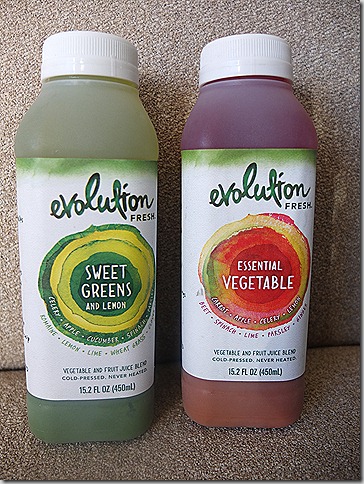
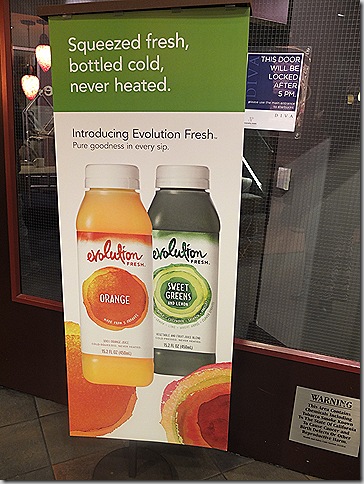
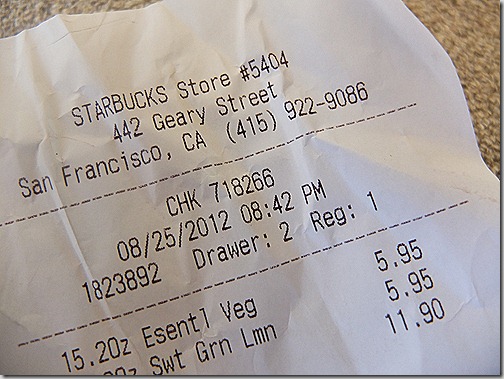
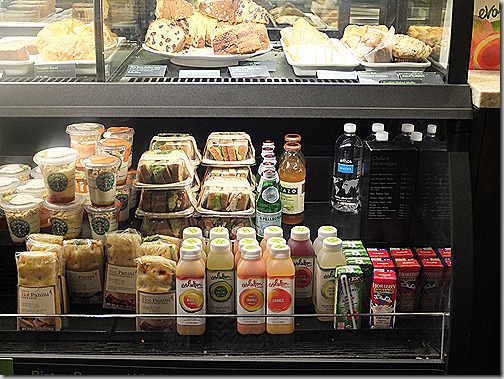
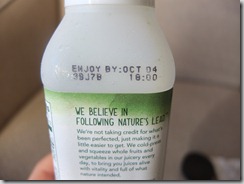
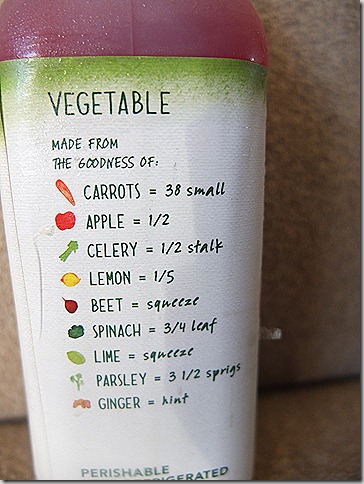
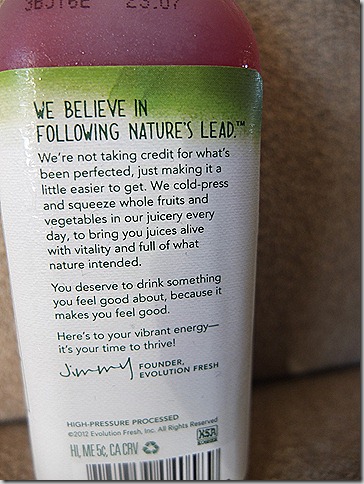
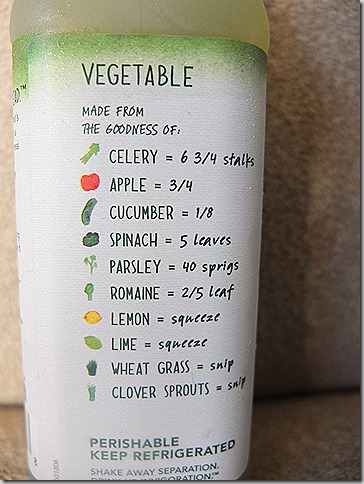








{ 2 comments… read them below or add one }
Great article! I actually purchase BluePrintJuice all the time and they actually just announced that they are 100% organic earlier this summer.
Thanks Ashley – I just updated the post!
{ 1 trackback }